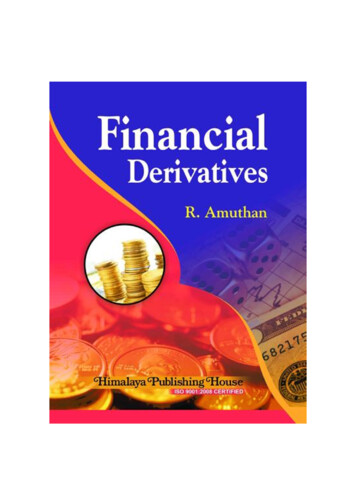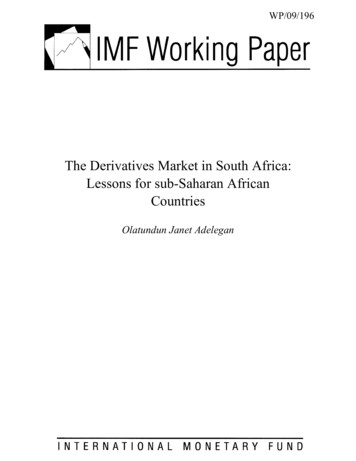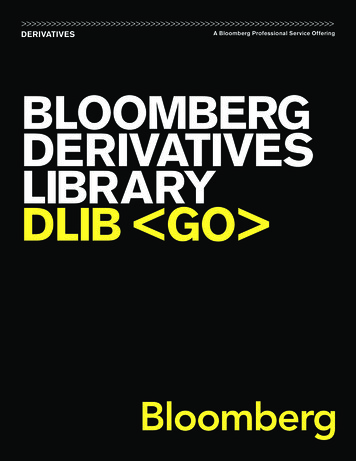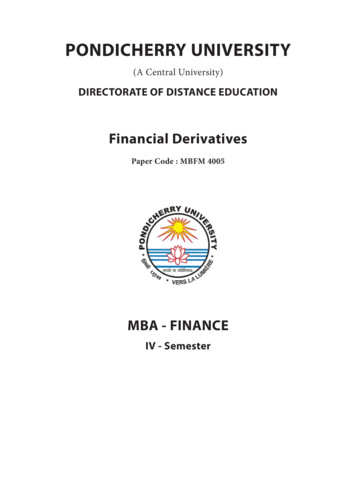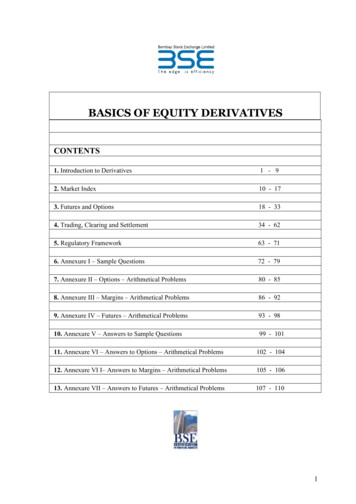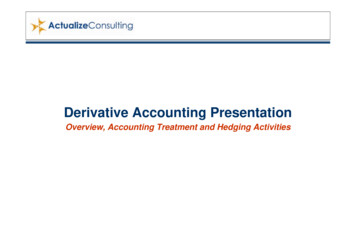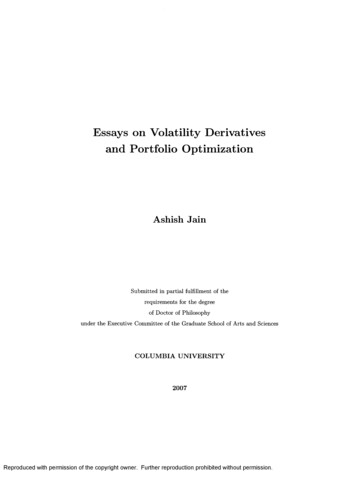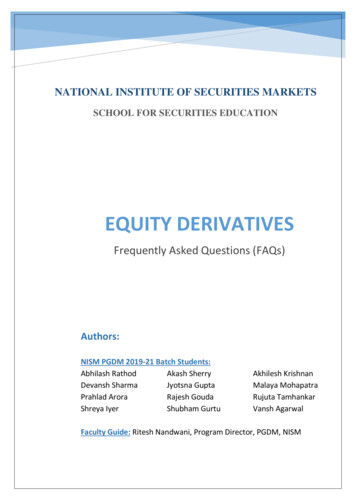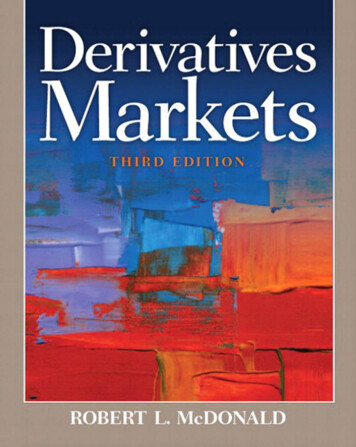
Transcription
Derivatives Markets
The Pearson Series in FinanceBekaert/HodrickInternational Financial ManagementHullFundamentals of Futures and Options MarketsBerk/DeMarzoCorporate Finance*HullOptions, Futures, and Other DerivativesBerk/DeMarzoCorporate Finance: The Core*KeownPersonal Finance: Turning Money into Wealth*Berk/DeMarzo/HarfordFundamentals of Corporate Finance*Keown/Martin/PettyFoundations of Finance: The Logic and Practice ofFinancial Management*BrooksFinancial Management: Core Concepts*Copeland/Weston/ShastriFinancial Theory and Corporate PolicyDorfman/CatherIntroduction to Risk Management and InsuranceEiteman/Stonehill/MoffettMultinational Business FinanceFabozziBond Markets: Analysis and StrategiesFabozzi/ModiglianiCapital Markets: Institutions and InstrumentsFabozzi/Modigliani/JonesFoundations of Financial Markets and InstitutionsFinklerFinancial Management for Public, Health, andNot-for-Profit OrganizationsKim/NofsingerCorporate GovernanceMaduraPersonal Finance*MarthinsenRisk Takers: Uses and Abuses of Financial DerivativesMcDonaldDerivatives MarketsMcDonaldFundamentals of Derivatives MarketsMishkin/EakinsFinancial Markets and InstitutionsMoffett/Stonehill/EitemanFundamentals of Multinational FinanceNofsingerPsychology of InvestingFrascaPersonal FinanceOrmiston/FraserUnderstanding Financial StatementsGitman/Joehnk/SmartFundamentals of Investing*PennacchiTheory of Asset PricingGitman/ZutterPrinciples of Managerial Finance*RejdaPrinciples of Risk Management and InsuranceGitman/ZutterPrinciples of Managerial Finance—Brief Edition*SeilerPerforming Financial Studies: A MethodologicalCookbookHaugenThe Inefficient Stock Market: What Pays Off and WhyHaugenThe New Finance: Overreaction, Complexity, andUniquenessSolnik/McLeaveyGlobal InvestmentsStretcher/MichaelCases in Financial ManagementHoldenExcel Modeling in Corporate FinanceTitman/Keown/MartinFinancial Management: Principles and Applications*HoldenExcel Modeling in InvestmentsTitman/MartinValuation: The Art and Science of CorporateInvestment DecisionsHughes/MacDonaldInternational Banking: Text and Cases* denotes MyFinanceLab titlesWeston/Mitchel/MulherinTakeovers, Restructuring, and Corporate GovernanceLog onto www.myfinancelab.com to learn more
Derivatives MarketsTH IRD EDITIO NRobert L. McDonaldNorthwestern UniversityKellogg School of ManagementBostonAmsterdamDelhiColumbusCape TownMexico CityIndianapolisDubaiSao PauloNew YorkLondonSydneyMadridSan FranciscoMilanHong KongMunichSeoulUpper Saddle RiverParis MontrealSingaporeTaipeiTorontoTokyo
Editor in Chief: Donna BattistaAcquisitions Editor: Katie RowlandEditorial Project Manager: Jill KolongowskiEditorial Assistant: Elissa Senra-SargentDirector of Marketing: Maggie MoylanMarketing Manager: Jami MinardDirector of Production: Erin GreggSenior Managing Editor: Nancy FentonProduction Project Manager: Carla ThompsonSenior Manufacturing Buyer: Carol MelvilleText Designer: Gina Hagen KolendaCover Designer: Bruce KenselaarCreative Director: Jayne ConteCover Art: Shutterstock/PokazMedia Director: Susan SchoenbergMedia Project Manager: Lisa RinaldiSupplements Editors: Kathryn Dinovo, Alison EusdenFull-Service Project Management: Cypress Graphics,Windfall SoftwarePrinter/Binder: Edwards BrothersCover Printer: Lehigh-Phoenix Color/HagerstownText Font: Times RomanCredits and acknowledgments borrowed from other sources and reproduced, with permission, in this textbook appear onthe appropriate page within text.Microsoft and/or its respective suppliers make no representations about the suitability of the information contained inthe documents and related graphics published as part of the services for any purpose. All such documents and relatedgraphics are provided "as is" without warranty of any kind. Microsoft and/or its respective suppliers hereby disclaimall warranties and conditions with regard to this information, including all warranties and conditions of merchantability,whether express, implied or statutory, fitness for a particular purpose, title and non-infringement. In no event shallMicrosoft and/or its respective suppliers be liable for any special, indirect or consequential damages or any damageswhatsoever resulting from loss of use, data or profits, whether in an action of contract, negligence or other tortious action,arising out of or in connection with the use or performance of information available from the services.The documents and related graphics contained herein could include technical inaccuracies or typographical errors.Changes are periodically added to the information herein. Microsoft and/or its respective suppliers may makeimprovements and/or changes in the product(s) and/or the program(s) described herein at any time. Partial screenshots may be viewed in full within the software version specified.Microsoft and Windows are registered trademarks of the Microsoft Corporation in the U.S.A. and other countries.Screen shots and icons reprinted with permission from the Microsoft Corporation. This book is not sponsored or endorsedby or affiliated with the Microsoft Corporation.Copyright 2013, 2006, 2003 by Pearson Education, Inc., publishing as Prentice Hall. All rights reserved. Manufacturedin the United States of America. This publication is protected by Copyright, and permission should be obtained from thepublisher prior to any prohibited reproduction, storage in a retrieval system, or transmission in any form or by any means,electronic, mechanical, photocopying, recording, or likewise. To obtain permission(s) to use material from this work,please submit a written request to Pearson Education, Inc., Permissions Department, One Lake Street, Upper SaddleRiver, New Jersey 07458, or you may fax your request to 201-236-3290.Many of the designations by manufacturers and sellers to distinguish their products are claimed as trademarks. Wherethose designations appear in this book, and the publisher was aware of a trademark claim, the designations have beenprinted in initial caps or all caps.Library of Congress Cataloging-in-Publication DataMcDonald, Robert L. (Robert Lynch)Derivatives markets / Robert L. McDonald. — 3rd ed.p. cm.Includes bibliographical references and index.ISBN-13: 978-0-321-54308-0 (hardcover)ISBN-10: 0-321-54308-4 (hardcover)1. Derivative securities. I. Title.HG6024.A3M394 20132012029875332.64 57—dc2310 9 8 7 6 5 4 3 2 1ISBN 10: 0-321-54308-4ISBN 13: 978-0-321-54308-0
For Irene, Claire, David, and Henry
BriefContentsPreface1xxiIntroduction to Derivatives1PART ONEInsurance, Hedging, and Simple Strategies232An Introduction to Forwards and Options3Insurance, Collars, and Other Strategies4Introduction to Risk ManagementPART TWOForwards, Futures, and Swaps2561891235Financial Forwards and Futures1256Commodity Forwards and Futures7Interest Rate Forwards and Futures8Swaps163195233PART THREEOptions 2639Parity and Other Option Relationships26510 Binomial Option Pricing: Basic Concepts29311 Binomial Option Pricing: Selected Topics32312 The Black-Scholes Formula34913 Market-Making and Delta-Hedging14 Exotic Options: I381409vii
viiiBrief ContentsPART FOURFinancial Engineering and Applications43515 Financial Engineering and Security Design16 Corporate Applications 46917 Real Options 509PART FIVEAdvanced Pricing Theory and Applications18 The Lognormal Distribution43754354519 Monte Carlo Valuation 57320 Brownian Motion and Itô’s Lemma60321 The Black-Scholes-Merton Equation 62722 Risk-Neutral and Martingale Pricing 64923 Exotic Options: II 68324252627Volatility 717Interest Rate and Bond DerivativesValue at Risk 789Credit Risk 815Appendix A The Greek Alphabet 851Appendix B Continuous CompoundingAppendix C Jensen’s Inequality 859751853Appendix D An Introduction to Visual Basic for ApplicationsGlossary883ReferencesIndex915897863
ContentsPrefaceChapter 1Introduction to Derivatives1.11.21.31.41.5PART ONExxiInsurance, Hedging, and SimpleStrategies 231What Is a Derivative? 2An Overview of Financial Markets 2Trading of Financial Assets 2Measures of Market Size and Activity 4Stock and Bond Markets 5Derivatives Markets 6The Role of Financial Markets 9Financial Markets and the Averages 9Risk-Sharing 10The Uses of Derivatives 11Uses of Derivatives 11Perspectives on Derivatives 13Financial Engineering and SecurityDesign 14Buying and Short-Selling FinancialAssets 14Transaction Costs and the Bid-AskSpread 14Ways to Buy or Sell 15Short-Selling 16The Lease Rate of an Asset 18Risk and Scarcity in Short-Selling 18Chapter Summary 20Further Reading 20Problems 20Chapter 2An Introduction to Forwards andOptions 252.12.22.3Forward Contracts 25The Payoff on a Forward Contract 29Graphing the Payoff on a ForwardContract 30Comparing a Forward and OutrightPurchase 30Zero-Coupon Bonds in Payoff and ProfitDiagrams 33Cash Settlement Versus Delivery 34Credit Risk 34Call Options 35Option Terminology 35Payoff and Profit for a Purchased CallOption 36Payoff and Profit for a Written CallOption 38Put Options 41Payoff and Profit for a Purchased PutOption 41Payoff and Profit for a Written PutOption 42The “Moneyness” of an Option 44ix
x2.42.52.62.AContentsSummary of Forward and OptionPositions 45Positions Long with Respect to theIndex 45Positions Short with Respect to theIndex 46Options Are Insurance 47Homeowner’s Insurance Is a PutOption 48But I Thought Insurance Is Prudent andPut Options Are Risky . . . 48Call Options Are Also Insurance 49Example: Equity-Linked CDs 50Graphing the Payoff on the CD 50Economics of the CD 52Why Equity-Linked CDs? 52Chapter Summary 53Further Reading 54Problems 55More on Buying a Stock Option 57Dividends 57Exercise 57Margins for Written Options 58Taxes 58Chapter 3Insurance, Collars, and OtherStrategies 613.13.23.33.4Basic Insurance Strategies 61Insuring a Long Position: Floors 61Insuring a Short Position: Caps 64Selling Insurance 66Put-Call Parity 68Synthetic Forwards 68The Put-Call Parity Equation 70Spreads and Collars 71Bull and Bear Spreads 71Box Spreads 73Ratio Spreads 74Collars 74Speculating on Volatility 79Straddles 79Butterfly Spreads 80Asymmetric Butterfly Spreads 82Chapter Summary 84Further Reading 86Problems 86Chapter 4Introduction to Risk Management4.14.24.34.44.589Basic Risk Management: The Producer’sPerspective 89Hedging with a Forward Contract 90Insurance: Guaranteeing a Minimum Pricewith a Put Option 91Insuring by Selling a Call 93Adjusting the Amount of Insurance 95Basic Risk Management: The Buyer’sPerspective 96Hedging with a Forward Contract 97Insurance: Guaranteeing a Maximum Pricewith a Call Option 97Why Do Firms Manage Risk? 99An Example Where Hedging AddsValue 100Reasons to Hedge 102Reasons Not to Hedge 104Empirical Evidence on Hedging 104Golddiggers Revisited 107Selling the Gain: Collars 107Other Collar Strategies 111Paylater Strategies 111Selecting the Hedge Ratio 112Cross-Hedging 112Quantity Uncertainty 114Chapter Summary 117Further Reading 118Problems 118PART TWOForwards, Futures, andSwaps 123Chapter 5Financial Forwards and Futures5.15.2125Alternative Ways to Buy a Stock 125Prepaid Forward Contracts on Stock 126Pricing the Prepaid Forward byAnalogy 127Pricing the Prepaid Forward by DiscountedPresent Value 127
Contents5.35.45.55.65.75.A5.B5.CPricing the Prepaid Forward byArbitrage 127Pricing Prepaid Forwards withDividends 129Forward Contracts on Stock 131Does the Forward Price Predict the FutureSpot Price? 132Creating a Synthetic ForwardContract 133Synthetic Forwards in Market-Making andArbitrage 135No-Arbitrage Bounds with TransactionCosts 136Quasi-Arbitrage 137An Interpretation of the Forward PricingFormula 138Futures Contracts 138The S&P 500 Futures Contract 139Margins and Marking to Market 140Comparing Futures and ForwardPrices 143Arbitrage in Practice: S&P 500 IndexArbitrage 143Quanto Index Contracts 145Uses of Index Futures 146Asset Allocation 146Cross-hedging with Index Futures 147Currency Contracts 150Currency Prepaid Forward 150Currency Forward 152Covered Interest Arbitrage 152Eurodollar Futures 153Chapter Summary 157Further Reading 158Problems 158Taxes and the Forward Rate 161Equating Forwards and Futures 162Forward and Futures Prices 162Chapter 6Commodity Forwards andFutures 1636.1Introduction to CommodityForwards 164Examples of Commodity FuturesPrices 1646.26.36.46.56.66.76.8Differences Between Commodities andFinancial Assets 166Commodity Terminology 166Equilibrium Pricing of CommodityForwards 167Pricing Commodity Forwards byArbitrage 168An Apparent Arbitrage 168Short-selling and the Lease Rate 170No-Arbitrage Pricing IncorporatingStorage Costs 172Convenience Yields 174Summary 175Gold 175Gold Leasing 176Evaluation of Gold Production 177Corn 178Energy Markets 179Electricity 180Natural Gas 180Oil 182Oil Distillate Spreads 184Hedging Strategies 185Basis Risk 186Hedging Jet Fuel with Crude Oil 187Weather Derivatives 188Synthetic Commodities 189Chapter Summary 191Further Reading 192Problems 192Chapter 7Interest Rate Forwards andFutures 1957.17.2Bond Basics 195Zero-Coupon Bonds 196Implied Forward Rates 197Coupon Bonds 199Zeros from Coupons 200Interpreting the Coupon Rate 201Continuously Compounded Yields 202Forward Rate Agreements, EurodollarFutures, and Hedging 202Forward Rate Agreements 203Synthetic FRAs 204Eurodollar Futures 206xi
xii7.37.47.57.AContentsDuration and Convexity 211Price Value of a Basis Point and DV01 211Duration 213Duration Matching 214Convexity 215Treasury-Bond and Treasury-NoteFutures 217Repurchase Agreements 220Chapter Summary 222Further Reading 224Problems 225Interest Rate and Bond PriceConventions 228Bonds 228Bills 230Chapter 8Swaps 2338.18.28.38.48.58.6An Example of a Commodity Swap 233Physical Versus Financial Settlement 234Why Is the Swap Price Not 110.50? 236The Swap Counterparty 237The Market Value of a Swap 238Computing the Swap Rate in General 240Fixed Quantity Swaps 240Swaps with Variable Quantity andPrice 241Interest Rate Swaps 243A Simple Interest Rate Swap 243Pricing and the Swap Counterparty 244Swap Rate and Bond Calculations 246The Swap Curve 247The Swap’s Implicit Loan Balance 248Deferred Swaps 249Related Swaps 250Why Swap Interest Rates? 251Amortizing and Accreting Swaps 252Currency Swaps 252Currency Swap Formulas 255Other Currency Swaps 256Swaptions 256Total Return Swaps 257Chapter Summary 259Further Reading 260Problems 261PART THREEOptions263Chapter 9Parity and Other OptionRelationships 2659.19.29.39.A9.BPut-Call Parity 265Options on Stocks 266Options on Currencies 269Options on Bonds 269Dividend Forward Contracts 269Generalized Parity and ExchangeOptions 270Options to Exchange Stock 272What Are Calls and Puts? 272Currency Options 273Comparing Options with Respect to Style,Maturity, and Strike 275European Versus American Options 276Maximum and Minimum OptionPrices 276Early Exercise for American Options 277Time to Expiration 280Different Strike Prices 281Exercise and Moneyness 286Chapter Summary 286Further Reading 287Problems 288Parity Bounds for American Options 291Algebraic Proofs of Strike-PriceRelations 292Chapter 10Binomial Option Pricing: BasicConcepts 29310.1 A One-Period Binomial Tree 293Computing the Option Price 294The Binomial Solution 295Arbitraging a Mispriced Option 297A Graphical Interpretation of the BinomialFormula 298Risk-Neutral Pricing 29910.2 Constructing a Binomial Tree 300
Contents10.310.410.510.610.AContinuously Compounded Returns 301Volatility 302Constructing u and d 303Estimating Historical Volatility 303One-Period Example with a ForwardTree 305Two or More Binomial Periods 306A Two-Period European Call 306Many Binomial Periods 308Put Options 309American Options 310Options on Other Assets 312Option on a Stock Index 312Options on Currencies 312Options on Futures Contracts 314Options on Commodities 315Options on Bonds 316Summary 317Chapter Summary 318Further Reading 319Problems 319Taxes and Option Prices 322Chapter 11Binomial Option Pricing: SelectedTopics 32311.1 Understanding Early Exercise 32311.2 Understanding Risk-Neutral Pricing 326The Risk-Neutral Probability 326Pricing an Option Using RealProbabilities 32711.3 The Binomial Tree and Lognormality 330The Random Walk Model 330Modeling Stock Prices as a RandomWalk 331The Binomial Model 332Lognormality and the Binomial Model 333Alternative Binomial Trees 335Is the Binomial Model Realistic? 33611.4 Stocks Paying Discrete Dividends 336Modeling Discrete Dividends 337Problems with the Discrete DividendTree 337A Binomial Tree Using the PrepaidForward 339xiiiChapter Summary 340Further Reading 341Problems 34111.A Pricing Options with TrueProbabilities 34311.B Why Does Risk-Neutral PricingWork? 344Utility-Based Valuation 344Standard Discounted Cash Flow 345Risk-Neutral Pricing 345Physical vs. Risk-Neutral Probabilities 346Example 347Chapter 12The Black-Scholes Formula34912.1 Introduction to the Black-ScholesFormula 349Call Options 349Put Options 352When Is the Black-Scholes FormulaValid? 35212.2 Applying the Formula to OtherAssets 353Options on Stocks with DiscreteDividends 354Options on Currencies 354Options on Futures 35512.3 Option Greeks 356Definition of the Greeks 356Greek Measures for Portfolios 361Option Elasticity 36212.4 Profit Diagrams Before Maturity 366Purchased Call Option 366Calendar Spreads 36712.5 Implied Volatility 369Computing Implied Volatility 369Using Implied Volatility 37012.6 Perpetual American Options 372Valuing Perpetual Options 373Barrier Present Values 374Chapter Summary 374Further Reading 375Problems 37512.A The Standard Normal Distribution 378
xivContents12.B Formulas for Option GreeksDelta ( ) 379Gamma ( ) 379Theta (θ) 379Vega 380Rho (ρ) 380Psi (ψ) 380379Chapter 13Market-Making and DeltaHedging 38113.1 What Do Market-Makers Do? 38113.2 Market-Maker Risk 382Option Risk in the Absence ofHedging 382Delta and Gamma as Measures ofExposure 38313.3 Delta-Hedging 384An Example of Delta-Hedging for 2Days 385Interpreting the Profit Calculation 385Delta-Hedging for Several Days 387A Self-Financing Portfolio: The StockMoves One σ 38913.4 The Mathematics of Delta-Hedging 389Using Gamma to Better Approximate theChange in the Option Price 390Delta-Gamma Approximations 391Theta: Accounting for Time 392Understanding the Market-Maker’sProfit 39413.5 The Black-Scholes Analysis 395The Black-Scholes Argument 396Delta-Hedging of American Options 396What Is the Advantage to FrequentRe-Hedging? 397Delta-Hedging in Practice 398Gamma-Neutrality 39913.6 Market-Making as Insurance 402Insurance 402Market-Makers 403Chapter Summary 403Further Reading 404Problems 40413.A Taylor Series Approximations 40613.B Greeks in the Binomial Model 407Chapter 14Exotic Options: I40914.1 Introduction 40914.2 Asian Options 410XYZ’s Hedging Problem 411Options on the Average 411Comparing Asian Options 412An Asian Solution for XYZ 41314.3 Barrier Options 414Types of Barrier Options 415Currency Hedging 41614.4 Compound Options 418Compound Option Parity 419Options on Dividend-Paying Stocks 419Currency Hedging with CompoundOptions 42114.5 Gap Options 42114.6 Exchange Options 424European Exchange Options 424Chapter Summary 425Further Reading 426Problems 42614.A Pricing Formulas for Exotic Options 430Asian Options Based on the GeometricAverage 430Compound Options 431Infinitely Lived Exchange Option 432PART FOURFinancial Engineering andApplications 435Chapter 15Financial Engineering and SecurityDesign 43715.1 The Modigliani-Miller Theorem 43715.2 Structured Notes without Options 438Single Payment Bonds 438Multiple Payment Bonds 44115.3 Structured Notes with Options 445Convertible Bonds 446Reverse Convertible Bonds 449Tranched Payoffs 451
ContentsVariable Prepaid Forwards 45215.4 Strategies Motivated by Tax andRegulatory Considerations 453Capital Gains Deferral 454Marshall & Ilsley SPACES 45815.5 Engineered Solutions forGolddiggers 460Gold-Linked Notes 460Notes with Embedded Options 462Chapter Summary 463Further Reading 464Problems 46417.217.317.4Chapter 16Corporate Applications46916.1 Equity, Debt, and Warrants 469Debt and Equity as Options 469Leverage and the Expected Return on Debtand Equity 472Multiple Debt Issues 477Warrants 478Convertible Bonds 479Callable Bonds 482Bond Valuation Based on the StockPrice 485Other Bond Features 485Put Warrants 48616.2 Compensation Options 487The Use of Compensation Options 487Valuation of Compensation Options 489Repricing of Compensation Options 492Reload Options 493Level 3 Communications 49516.3 The Use of Collars in Acquisitions 499The Northrop Grumman—TRWmerger 499Chapter Summary 502Further Reading 503Problems 50316.A An Alternative Approach to ExpensingOption Grants 507Chapter 17Real Options50917.1 Investment and the NPV RuleStatic NPV 51050917.517.A17.BxvThe Correct Use of NPV 511The Project as an Option 511Investment under Uncertainty 513A Simple DCF Problem 513Valuing Derivatives on the Cash Flow 514Evaluating a Project with a 2-YearInvestment Horizon 515Evaluating the Project with an InfiniteInvestment Horizon 519Real Options in Practice 519Peak-Load Electricity Generation 519Research and Development 523Commodity Extraction as an Option 525Single-Barrel Extraction underCertainty 525Single-Barrel Extraction underUncertainty 528Valuing an Infinite Oil Reserve 530Commodity Extraction with Shutdownand Restart Options 531Permanent Shutting Down 533Investing When Shutdown Is Possible 535Restarting Production 536Additional Options 537Chapter Summary 538Further Reading 538Problems 538Calculation of Optimal Time to Drill anOil Well 541The Solution with Shutting Down andRestarting 541PART FIVEAdvanced Pricing Theory andApplications 543Chapter 18The Lognormal Distribution54518.1 The Normal Distribution 545Converting a Normal Random Variable toStandard Normal 548Sums of Normal Random Variables 54918.2 The Lognormal Distribution 55018.3 A Lognormal Model of Stock Prices 552
xviContents18.4 Lognormal Probability Calculations 556Probabilities 556Lognormal Prediction Intervals 557The Conditional Expected Price 559The Black-Scholes Formula 56118.5 Estimating the Parameters of a LognormalDistribution 56218.6 How Are Asset Prices Distributed? 564Histograms 564Normal Probability Plots 566Chapter Summary 569Further Reading 569Problems 57018.A The Expectation of a LognormalVariable 57118.B Constructing a Normal ProbabilityPlot 572Chapter 19Monte Carlo Valuation57319.1 Computing the Option Price as aDiscounted Expected Value 573Valuation with Risk-NeutralProbabilities 574Valuation with True Probabilities 57519.2 Computing Random Numbers 57719.3 Simulating Lognormal Stock Prices 578Simulating a Sequence of Stock Prices 57819.4 Monte Carlo Valuation 580Monte Carlo Valuation of a EuropeanCall 580Accuracy of Monte Carlo 581Arithmetic Asian Option 58219.5 Efficient Monte Carlo Valuation 584Control Variate Method 584Other Monte Carlo Methods 58719.6 Valuation of American Options 58819.7 The Poisson Distribution 59119.8 Simulating Jumps with the PoissonDistribution 593Simulating the Stock Price withJumps 593Multiple Jumps 59619.9 Simulating Correlated Stock Prices 597Generating n Correlated LognormalRandom Variables 597Chapter Summary 599Further Reading 599Problems 59919.A Formulas for Geometric AverageOptions 602Chapter 20Brownian Motion and Itô’sLemma 60320.1 The Black-Scholes Assumption aboutStock Prices 60320.2 Brownian Motion 604Definition of Brownian Motion 604Properties of Brownian Motion 606Arithmetic Brownian Motion 607The Ornstein-Uhlenbeck Process 60820.3 Geometric Brownian Motion 609Lognormality 609Relative Importance of the Drift and NoiseTerms 610Multiplication Rules 610Modeling Correlated Asset Prices 61220.4 Itô’s Lemma 613Functions of an Itô Process 614Multivariate Itô’s Lemma 61620.5 The Sharpe Ratio 61720.6 Risk-Neutral Valuation 618A Claim That Pays S(T )a 619Specific Examples 620Valuing a Claim on S a Qb 62120.7 Jumps in the Stock Price 623Chapter Summary 624Further Reading 624Problems 62420.A Valuation Using Discounted CashFlow 626Chapter 21The Black-Scholes-MertonEquation 62721.1 Differential Equations and Valuationunder Certainty 627The Valuation Equation 628Bonds 628Dividend-Paying Stocks 629
Contents21.221.321.421.521.A21.B21.CThe General Structure 629The Black-Scholes Equation 629Verifying the Formula for a Derivative 631The Black-Scholes Equation andEquilibrium Returns 634What If the Underlying Asset Is Not anInvestment Asset? 635Risk-Neutral Pricing 637Interpreting the Black-ScholesEquation 637The Backward Equation 637Derivative Prices as Discounted ExpectedCash Flows 638Changing the Numeraire 639Option Pricing When the Stock Price CanJump 642Merton’s Solution for DiversifiableJumps 643Chapter Summary 644Further Reading 644Problems 645Multivariate Black-Scholes Analysis 646Proof of Proposition 21.1 646Solutions for Prices and Probabilities 647Chapter 22Risk-Neutral and MartingalePricing 64922.1 Risk Aversion and Marginal Utility 65022.2 The First-Order Condition for PortfolioSelection 65222.3 Change of Measure and Change ofNumeraire 654Change of Measure 655The Martingale Property 655Girsanov’s Theorem 65722.4 Examples of Numeraire and MeasureChange 658The Money-Market Account as Numeraire(Risk-Neutral Measure) 659Risky Asset as Numeraire 662Zero Coupon Bond as Numeraire (ForwardMeasure) 66222.5 Examples of Martingale Pricing 663Cash-or-Nothing Call 66322.622.A22.B22.CxviiAsset-or-Nothing Call 665The Black-Scholes Formula 666European Outperformance Option 667Option on a Zero-Coupon Bond 667Example: Long-Maturity Put Options 667The Black-Scholes Put PriceCalculation 668Is the Put Price Reasonable? 669Discussion 671Chapter Summary 671Further Reading 673Problems 673The Portfolio Selection Problem 676The One-Period Portfolio SelectionProblem 676The Risk Premium of an Asset 678Multiple Consumption and InvestmentPeriods 679Girsanov’s Theorem 679The Theorem 679Constructing Multi-Asset Processes fromIndependent Brownian Motions 680Risk-Neutral Pricing and Marginal Utilityin the Binomial Model 681Chapter 23Exotic Options: II68323.1 All-or-Nothing Options 683Terminology 683Cash-or-Nothing Options 684Asset-or-Nothing Options 685Ordinary Options and Gap Options 686Delta-Hedging All-or-NothingOptions 68723.2 All-or-Nothing Barrier Options 688Cash-or-Nothing Barrier Options 690Asset-or-Nothing Barrier Options 694Rebate Options 694Perpetual American Options 69523.3 Barrier Options 69623.4 Quantos 697The Yen Perspective 698The Dollar Perspective 699A Binomial Model for the DollarDenominated Investor 701
xviiiContents23.5 Currency-Linked Options 704Foreign Equity Call Struck in ForeignCurrency 705Foreign Equity Call Struck in DomesticCurrency 706Fixed Exchange Rate Foreign EquityCall 707Equity-Linked Foreign Exchange Call 70723.6 Other Multivariate Options 708Options on the Best of Two Assets 709Basket Options 710Chapter Summary 711Further Reading 711Problems 71223.A The Reflection Principle 715Chapter 24Volatility 71724.1 Implied Volatility 71824.2 Measurement and Behavior ofVolatility 720Historical Volatility 720Exponentially Weighted MovingAverage 721Time-Varying Volatility: ARCH 723The GARCH Model 727Realized Quadratic Variation 72924.3 Hedging and Pricing Volatility 731Variance and Volatility Swaps 731Pricing Volatility 73324.4 Extending the Black-Scholes Model 736Jump Risk and Implied Volatility 737Constant Elasticity of Variance 737The Heston Model 740Evidence 742Chapter Summary 745Further Reading 745Problems 746Chapter 25Interest Rate and BondDerivatives 75125.1 An Introduction to Interest RateDerivatives 752Bond and Interest Rate Forwards 75225.225.325.425.525.AOptions on Bonds and Rates 753Equivalence of a Bond Put and an InterestRate Call 754Taxonomy of Interest Rate Models 754Interest Rate Derivatives and theBlack-Scholes-Merton Approach 756An Equilibrium Equation for Bonds 757Continuous-Time Short-Rate Models 760The Rendelman-Bartter Model 760The Vasicek Model 761The Cox-Ingersoll-Ross Model 762Comparing Vasicek and CIR 763Duration and Convexity Revisited 764Short-Rate Models and Interest RateTrees 765An Illustrative Tree 765The Black-Derman-Toy Model 769Hull-White Model 773Market Models 780The Black Model 780LIBOR Market Model 781Chapter Summary 783Further Reading 784Problems 784Constructing the BDT Tree 787Chapter 26Value at Risk78926.1 Value at Risk 789Value at Risk for One Stock 793VaR for Two or More Stocks 795VaR for Nonlinear Portfolios 796VaR for Bonds 801Estimating Volatility 805Bootstrapping Return Distributions 80626.2 Issues with VaR 807Alternative Risk Measures 807VaR and the Risk-Neutral Distribution 810Subadditive Risk Measures 811Chapter Summary 812Further Reading 813Problems 813Chapter 27Credit Risk81527.1 Default Concepts and Terminology815
Contents27.2 The Merton Default Model 817Default at Maturity 817Related Models 81927.3 Bond Ratings and DefaultExperience 821Rating Transitions 822Recovery Rates 824Reduced Form Bankruptcy Models 82427.4 Credit Default Swaps 826Single-Name Credit Default Swaps 826Pricing a Default Swap 828CDS Indices 832Other Credit-Linked Structures 83427.5 Tranched Structures 834Collateralized Debt Obligations 836CDO-Squareds 840Nth to default baskets 842Chapter Summary 844Further Reading 846Problems 846Appendix AThe Greek Alphabet851Appendix BContinuous CompoundingB.1B.2Appendix CJensen’s InequalityC.1C.2C.3853The Language of Interest Rates 853The Logarithmic and ExponentialFunctions 854Changing Interest Rates 855Symmetry for Increases and Decreases 855Problems 856859Example: The Exponential FunctionExample: The Price of a Call 860Proof of Jensen’s Inequality 861Problems 862859D.2D.3How to Learn VBA 864Calculations with VBA 864Creating a Simple Function 864A Simple Example of a Subroutine 865Creating a Button to Invoke aSubroutine 866Functions Can Call Functions 867Illegal Function Names 867Differences between Functions andSubroutines 867D.4 Storing and Retrieving Variables in aWorksheet 868Using a Named Range to Read and WriteNumbers from the Spreadsheet 868Reading and Writing to Cells That Are NotNamed 869Using the Cells Function to Read andWrite to Cells 870Reading
Principles of Managerial Finance—Brief Edition* Haugen The Inefficient Stock Market: What Pays Off and Why . Derivatives markets / Robert L. McDonald. — 3rd ed. p. cm. Includes bibliographical references and index. ISBN-13: 978--321-54308- (hardcover) . Derivatives Markets 6 1.3 The Role of Financial Markets 9 Financial Markets and .
